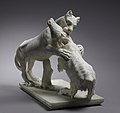Francesco Antonio Franzoni
 | |
| Data i miejsce urodzenia | 23 stycznia 1734 |
|---|---|
| Data i miejsce śmierci | 3 marca 1818 |
| Narodowość | |
| Dziedzina sztuki | rzeźbiarstwo |
Francesco Antonio Franzoni (ur. 23 stycznia 1734 w Carrarze, zm. 3 marca 1818 w Rzymie) – włoski rzeźbiarz i restaurator.
Życiorys
Francesco Antonio Franzoni urodził się w Carrarze 23 stycznia 1734 roku. Od 1758 roku był aktywny w Rzymie. Pod koniec lat sześćdziesiątych XVIII wieku pracował przy restauracji kolekcji Giovanniego Battisty Piranesiego. Zatrudniony został, najpierw przez papieża Klemensa XIV, następnie Piusa VI do restauracji posągów w Museo Pio-Clementino. W latach 1776–1784 brał udział w dekorowaniu zakrystii w Bazylice św. Piotra. Zmarł 3 marca 1818 w Rzymie[1].
Przypisy
- ↑ Rosella Carloni: Francesco Antonio Franzoni (Dizionario Biografico degli Italiani) (wł.). treccani.it. [dostęp 2022-06-27].
Media użyte na tej stronie
Autor: Sailko, Licencja: CC BY-SA 4.0
This is a photo of a monument which is part of cultural heritage of Italy. This monument participates in the contest Wiki Loves Monuments Italia 2022. See authorisations.
Autor:
One of the best known restorers of ancient sculpture, Franzoni often invented totally new compositions from small fragments. However, this sculpture is entirely Franzoni’s own work, down to the breaks seen in such places as the panther’s tail and the goat’s legs and jaw. Curiously, Franzoni based this work on one of his own restorations, now in the Vatican, although his composition here is more
balanced and elegant, in keeping with ideas in the late 1700s about how ancient sculpture should look.Autor: Yair Haklai, Licencja: CC BY-SA 4.0
Hermes tying his sandal. Modern replica of Lysippos. Ancient head (from a Barracco-type statue of Heracles); modern body, sculpted by Francesco Antonio Franzoni at the end of the 18th century
Autor: Hiart, Licencja: CC0
Pair of Leopards, attributed to Francesco Antonio Franzoni, intarsia (marble with marble inlay), Honolulu Museum of Art, accessions 3240.1, 3241.1






